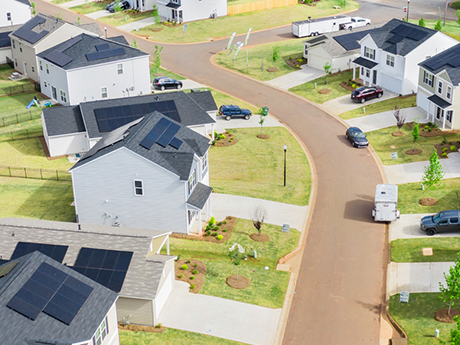By Richard Ross, CEO of Quinn Residences
Climate change is an enormous topic with implications so expansive that it can be difficult to understand how — or even if — we can make a positive impact.
While companies and individuals can make essential changes on the margins, like advocating for public policies that promote better climate outcomes, there is one place where everyone can make a distinct difference: at home.
The built environment is one of the most significant contributors to climate change, and our residences account for much of our carbon footprint. Changing how we build and what we buy or rent can alter this dynamic, and for new builds, this process starts on day one.

Here are five ways in which developers, builders, buyers and renters can make that possible.
Implement a Solar Program
Rooftop solar panel adoption is soaring, setting installation records for six consecutive years. More than 700,000 homeowners installed solar panels in 2022, and over half of U.S. adults say they “want to power their home with solar panels in the future.”
Meanwhile, the costs of installing and maintaining solar panels have never been lower, thanks to cheaper material costs, streamlined permitting processes and workforce efficiencies. Last year, the average cost of a rooftop installation approached $25,000, a significant drop from the $50,000 price tag just a decade ago.
This decrease in costs creates opportunities for multifamily developers and single-family homebuilders looking to increase the value of their properties at construction. According to one analysis by the National Renewable Energy Laboratory, installing solar panels during construction can be significantly cheaper than adding them afterward, and the value extends long after construction is completed.
Especially for investors in single-family rental (SFR) properties, installing solar panels during construction can reduce residents’ electricity bills by 20 percent, and tenants love it, increasing both renter satisfaction and property values in the process.
Pre-Wire Buildings for Electric Vehicle Chargers
Electric vehicle (EV) sales are climbing as an overall percentage of cars sold, increasing by 47 percent year-over-year. For those that haven’t yet made the leap, 40 percent say they are “very or somewhat likely to seriously consider an electric vehicle for their next vehicle purchase.”
The most potent obstacle to adoption is central to its form: charging.
According to a poll by the Energy Policy Institute at the University of Chicago and the Associated Press-NORC Center for Public Affairs Research, the lack of charging infrastructure is one of the key hurdles to adoption for 80 percent of would-be EV buyers.
While builders and developers can’t control national charging infrastructure, they can make at-home charging a simple, safe and efficient process by pre-wiring new projects for future EV use.
Critically, an EV-ready home offers homeowners a future-proof and cost-saving feature by providing safe access to a dedicated 240-volt power supply for faster EV charging. By pre-wiring new homes during construction, builders can avoid hundreds of dollars in future expenses while enticing electric-minded renters or buyers to prioritize their properties.
Design Buildings for Durability
Future-proofing new construction isn’t the only way to maximize climate impact for new construction. Developers and builders can make materials last longer by prioritizing build quality and long-term durability.
For example, rather than installing carpet to cheaply cover concrete floors, use hard surface flooring that lasts longer and requires less maintenance.
This simple design principle reflects a commitment to sustainability, as it eliminates the need for homeowners to replace carpeting every few years, reducing waste and the environmental impact of frequent flooring replacement in the process.
Similar investments in residential features like energy-efficient windows and doors or natural materials can enhance a property’s long-term durability and minimize its lifetime environmental impact.
Prioritize Efficient Appliances
Major home appliances are shockingly energy-intensive. According to one analysis, residential home appliances account for 20 percent of U.S. greenhouse gas emissions, a staggering total that illustrates the potential for more efficient appliances to meaningfully improve the impacts that apartments and single-family homes have on climate change.
Since major home appliances can last for decades, making energy-efficient choices on day one will maximize results. Builders and developers can achieve this with just a few strategic selections.
Start by choosing Energy Star-certified appliances, a designation that guarantees that the devices are among the most energy-efficient on the market. At the same time, prioritize LED lighting fixtures that will provide that same level of illumination while using a fraction of the electricity. Lastly, maximize efficiency from HVAC units or consider alternative solutions, like heat pumps, that maintain climate control standards without compromising efficiency.
Incorporate a Tech Package
Incorporating a “tech package” in multifamily or single-family construction is a strategic move for developers and builders aiming to enhance energy management and safety.
This package can turn energy-inefficient analog homes into smart buildings with features like programmable thermostats that allow residents to customize and control their heating and cooling settings remotely.
This not only improves comfort, but also reduces unnecessary energy consumption, particularly in cases where residents may forget to adjust settings when leaving home.
To accompany this indoor technology, consider adding smart lighting systems that adjust based on natural light levels and occupancy and energy monitors that provide real-time feedback on power consumption. Taking these steps empowers renters and homeowners to make more informed choices on energy consumption.
Similarly, automated water systems can optimize usage for landscaping based on weather patterns and soil moisture levels, thus conserving water. Leak detectors add a layer of protection by promptly alerting apartment owners and homeowners to any water leaks, potentially preventing costly damages and water waste.
Sustainability Starts on Day One
The built environment represents a challenge and an opportunity for positive climate impact. While our apartments and homes are significant contributors to climate change, changing the way we build and maintain these essential buildings can be a catalyst for long-term change.
These forward-thinking strategies meet the growing consumer demand for eco-friendly living and set a new standard in residential construction that prioritizes energy efficiency, durability and smart technology.
Simply put, as we navigate the challenges posed by climate change, it’s clear that sustainability starts on day one of a residential construction endeavor and produces long-lasting benefits for developers, renters, homeowners and the planet alike.
— Based in Atlanta, Quinn Residences is an institutionally backed owner, operator and developer of rental communities in the Southeast.


